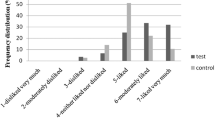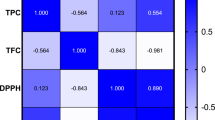Abstract
Concerns about the nutritional and sensory qualities of gluten-free (GF) products has generated interest in the evaluation of novel gluten-free ingredients. Folate content is of particular interest due to limited sources of enriched folic acid in a GF diet as well as lack of nutrient composition data in novel flours. The aim of this study was to determine the total folate content and chemical composition of GF flours commercially available in Canada. A tri-enzyme method was used to extract folate from the flour samples, and a microbiological assay was used to measure the total folate contents. The chemical compositions of the GF flours were determined according to standard Association of Official Agricultural Chemists (AOAC) International methods. Compared to all-purpose flour, 265 ± 6.9 μg/100 (dry-weight basis), chickpea flour registered the highest folate content 451 ± 10.8 μg/100 (dry-weight basis) followed by quinoa flour, 174 ± 12.4 μg/ 100 g folate (dry-weight basis). Fonio, had a total starch content of ~77% but was not a source of folate. Flaxseed, chickpea, chia and coconut flours had the highest reported protein contents (mean value: 21.3 ± 1.3%) whereas flaxseed (~42%), and chia (~35%), had the highest lipid content. These findings may inform the selection of gluten-replacement flours with acceptable nutritional properties.

Similar content being viewed by others
References
Mitchell S, Gomes A, Zelig R, Parker A (2019) Not all grains are created equal: gluten-free products not included in mandatory folate fortification. Curr Dev Nutr 3(5):1–3. https://doi.org/10.1093/cdn/nzz020
Naqash F, Gani A, Gani A, Masoodi FA (2017) Gluten-free baking: combating the challenges - a review. Trends Food Sci Technol 66:98–107. https://doi.org/10.1016/j.tifs.2017.06.004
Capriles V, Arêas J (2014) Novel approaches in gluten-free breadmaking: interface between food science, nutrition, and health. Compreh Rev Food Sci Food Safety 13(5):871–890. https://doi.org/10.1111/1541-4337.12091
Statista (2019) Retail sales of gluten-free food in Canada from 2008 to 2017 (in million Canadian dollars) [Graph]. In Statista. https://www.statista.com/statistics/441734/gluten-free-food-sales-canada/. Accessed 17 July 2019
Aziz I, Branchi F, Pearson K, Priest J, Sanders DS (2015) A study evaluating the bidirectional relationship between inflammatory bowel disease and self-reported non-celiac gluten sensitivity. Inflamm Bowel Dis 21:847–853. https://doi.org/10.1097/MIB.0000000000000335
McAllister BP, Williams E, Clarke KA (2019) Comprehensive review of celiac disease/gluten-sensitive enteropathies. Clin Rev Allergy Immunol 57(2):226–342. https://doi.org/10.1007/s12016-018-8691-2
Xhakollari V, Canavari M, Osman M (2019) Factors affecting consumers’ adherence to gluten-free diet, a systematic review. Trends Food Sci Technol 85:23–33. https://doi.org/10.1016/j.tifs.2018.12.005
Christoph M, Larson N, Hootman K, Miller J, Neumark-Sztainer D (2018) Who values gluten-free? Dietary intake, behaviors, and sociodemographic characteristics of young adults who value gluten-free food. J Acad Nutr Diet 118:1389–1398. https://doi.org/10.1016/j.jand.2018.04.007
Gaesser GA, Angadi SS (2015) Navigating the gluten-free boom. JAAPA 28(8):1–7. https://doi.org/10.1097/01.JAA.0000469434.67572.a4
Missbach B, Schwingshackl L, Billmann A, Mystek A, Hickelsberger M, Bauer G, König J (2015) Gluten-free food database: the nutritional quality and cost of packaged gluten-free foods. PeerJ 3:e1337. https://doi.org/10.7717/peerj.1337
Jamieson JA, Weir M, Gougeon L (2018) Canadian packaged gluten-free foods are less nutritious than their regular gluten-containing counterparts. PeerJ 6:e5875. https://doi.org/10.7717/peerj.5875
Yazynina E, Johansson M, Jägerstad M, Jastrebova J (2008) Low folate content in gluten-free cereal products and their main ingredients. Food Chem 111:236–242. https://doi.org/10.1016/j.foodchem.2008.03.055
Hegedus M, Pedersen B, Eggum BO (1985) The influence of milling on the nutritive value of flour from cereal grains. 7. Vitamins and tryptophan. Plant Foods Hum Nutr 35(2):175–180. https://doi.org/10.1007/BF01092134
Government of Canada (2018) Food and drug regulations. Department of justice laws. http://laws-lois.justice.gc.ca/PDF/C.R.C.,_c._870.pdf. Accessed 17 July 2019
Shewry PR, Hey SJ (2015) The contribution of wheat to human diet and health. Food Energy Secur 4(3):178–202. https://doi.org/10.1002/fes3.64
Government of Canada (2015) Canadian nutrient file. 2015 Ed. Ottawa: Government of Canada. https://food-nutrition.canada.ca/cnf-fce/index-eng.jsp. Accessed 17 July 2019
DeVries J, Rader J, Keagy P, Hudson C, Angyal G, Arcot J, Castelli M et al (2005) Microbiological assay-trienzyme procedure for total folates in cereals and cereal foods: collaborative study. J AOAC Int 88(1):5–15
Saini R, Nile S, Keum Y-S (2016) Folates: chemistry, analysis, occurrence, biofortification. Food Res Int 89:1–13. https://doi.org/10.1016/j.foodres.2016.07.013
AOAC (2005) Ash of flour (direct method), method 923.03. In: Official methods of analysis, 18th edn. AOAC International Publisher, Gaithersburg
Malcolmson L, Boux G, Bellido AS, Frohlich P (2013) Use of pulse ingredients to develop healthier baked products. Cereal Foods World 58:27–32. https://doi.org/10.1094/CFW-58-1-0027
Hemery Y, Fontan L, Laillou A, Jallier V, Moench-Pfanner R, Avallone S, Berger J (2020) Influence of storage conditions and packaging of fortified wheat flour on microbial load and stability of folate and vitamin B12. Food Chem 5:1–10. https://doi.org/10.1016/j.fochx.2019.100076
Shahid M, Lian T, Wan X, Jiang L, Han L, Zhang C, Liang Q (2020) Folate monoglutamate in cereal grains: evaluation of extraction techniques and determination by LC-MS/MS. J Food Comp Anal 91:1–8. https://doi.org/10.1016/j.jfca.2020.103510
Singh J (2018) Folate content in legumes. Biomed J Sci Tech Res 3:1–6. https://doi.org/10.26717/BJSTR.2018.03.000940
Hager AS, Wolter A, Jacob F, Zannini E, Arendt EK (2012) Nutritional properties and ultra-structure of commercial gluten free flours from different botanical sources compared to wheat flours. J Cereal Sci 56(2):239–247. https://doi.org/10.1016/j.jcs.2012.06.005
Bonafaccia G, Marocchini I, Kreft I (2003) Composition and technological properties of the flour and bran from common and tartary buckwheat. Food Chem 80:9–15. https://doi.org/10.1016/S0308-8146(02)00228-5
Hefni ME, Schaller F, Witthoft CM (2018) Betaine, choline and folate content in different cereal genotypes. J Cereal Sci 80:72–79. https://doi.org/10.1016/j.jcs.2018.01.013
Yazynina E, Johansson M, Jägerstad M, Jastrebova J (2008) Low folate content in gluten-free cereal products and their main ingredients. Food Chem 111:236–242. https://doi.org/10.1016/j.foodchem.2008.03.055
United States Department of Agriculture (2018) National nutrient database for standard reference legacy release. https://ndb.nal.usda.gov/. Accessed 19 July 2019
de Lamo B, Gómez M (2018) Bread enrichment with oilseeds. A Review. Foods 7:1–14. https://doi.org/10.3390/foods7110191
Schorno A, Manthey F, Hall C III (2010) Effect of particle size and sample size on lipid stability of milled flaxseed (Linum usitatissimum L). J Food Proc Pres 34:167–179. https://doi.org/10.1111/j.1745-4549.2009.00463.x
Sreerama Y, Sashikala V, Pratape V, Singh V (2012) Nutrients and antinutrients in cowpea and horse gram flours in comparison to chickpea flour: evaluation of their flour functionality. Food Chem 131:462–468. https://doi.org/10.1016/j.foodchem.2011.09.008
Ziobro R, Juszczak L, Witczak M, Korus J (2016) Non-gluten proteins as structure forming agents in gluten free bread. J Food Sci Technol 53:571–580. https://doi.org/10.1007/s13197-015-2043-5
Gull A, Prasad K, Kumar P (2015) Effect of millet flours and carrot pomace on cooking qualities, color and texture of developed pasta. LWT - Food Sci Technol 63(1):470–474. https://doi.org/10.1016/j.lwt.2015.03.008
Acknowledgments
A University Council on Research (UCR) grant to J. Jamieson and M. English assisted in the completion of this study. The authors also wish to acknowledge the dedicated work of research assistant Jacqueline Rusin.
Author information
Authors and Affiliations
Contributions
JA Jamieson: Conceptualization, Writing- Original draft preparation, Supervision, and Resources. L. Viana: Methodology, Investigation, Writing and Reviewing; M. English: Conceptualization, Writing- Major Reviewing and Editing, Data Curation, Formal Analysis, and Supervision.
Corresponding author
Ethics declarations
Conflict of Interest
The authors declare no conflict of interest.
Additional information
Publisher’s Note
Springer Nature remains neutral with regard to jurisdictional claims in published maps and institutional affiliations.
Rights and permissions
About this article
Cite this article
Jamieson, J.A., Viana, L. & English, M.M. Folate Content and Chemical Composition of Commercially Available Gluten-Free Flour Alternatives. Plant Foods Hum Nutr 75, 337–343 (2020). https://doi.org/10.1007/s11130-020-00833-z
Published:
Issue Date:
DOI: https://doi.org/10.1007/s11130-020-00833-z




